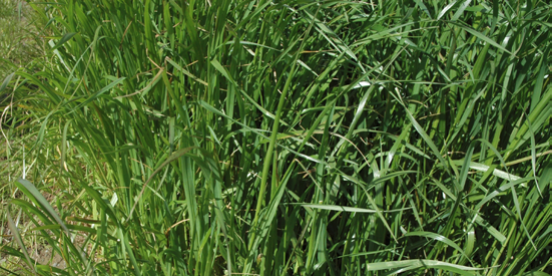It is important to remember that earlier sowing will increase the yield potential of these crops and good weather conditions are required at and after sowing to maximise their potential.
The crops listed have the potential to produce tonnes of dry matter in the short term, an invaluable resource where fodder is scarce. A 2 ha crop yielding 6 t DM/ha should keep 50 weanlings for 53 days.
Hybrid Brassica
Hybrid brassicas have the potential to yield 6 t DM/ha when sown in early August, and can be grazed in situ. Suitable for feeding dry cows, replacement heifers, weanlings and store cattle, advice pertinent to feeding brassicas applies of course. They are an appropriate choice for maximising yield when a full reseed is planned next year or as a catch crop after cereals.

Variety of choice: Redstart
Hybrid Ryegrass
Hybrid ryegrass does not have the same short–term yield potential as hybrid brassica, but does have other potential benefits. There will be extra grazing available in the spring, and in the context of building fodder stocks on farms in the next couple of years, this crop could play an important role.
Hybrid ryegrass has the potential to yield 16 t DM/ha, but it is important to use varieties with good quality. There are debatable economies when sown as a catch crop, but where fodder is scarce this should be considered.

Varieties of choice: AberEve and AberEcho
Forage Rape
Sown in early/mid–August, this crop has the potential to yield 5 t DM/ha, and can be grazed in-situ. Management appropriate for a growing and feeding a brassica crop should be applied. This is not a difficult crop to grow and is a suitable option as a catch crop or in a field targeted for reseeding.

Variety of choice – Stego
Stubble Turnips
Stubble turnips sown in early August have the potential to yield 5tDM/ha. They are not as winter hardy as hybrid brassicas such as Redstart and Swift and are only suitable for grazing in situ. Management appropriate to a brassica crop should apply.

Variety of choice – Appin
Italian Ryegrass
Italian ryegrass is similar in profile to hybrid ryegrass; it has similar short–term yield but less persistency than the hybrids with potential lower quality.

Variety of choice: Barextra
Westerwolds Ryegrass
This is an annual form of Italian ryegrass. It only grows for one year, so is not as suitable where the intention is to build forage stocks for the long term. In the short term it will deliver yields similar to hybrid ryegrass.
Variety of choice: Bartiga
